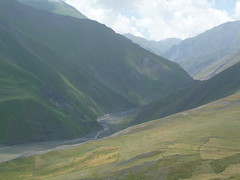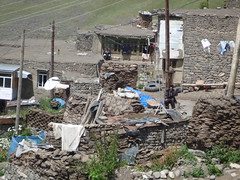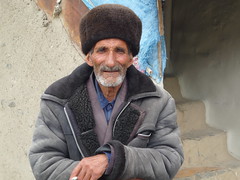We were woken at 8.30 by a frantic knock on the door. It was Dzavid. He marched in and first scolded us for sleeping with the window closed.'It's too hot in here and there is no oxygen. How can you breath?'. He went on to explain that some complications had arisen and that we should go to the bazaar, buy some groceries and then find an alternative 4WD. At least, I think that's what he said. He then tagged on that he would accompany us to Xınalıq. We were packed and out in 10 minutes, then took the marshrutka to the bazaar. David was in an excited mood, telling me that he had never been to Xınalıq and that he wants to see the villate.
This would be his first time. Strangely the 4WD which we had arranged with Ramazan yesterday was ready and waiting. We just loaded our stuff into the back, then went off around the bazaar to buy groceries - cheese, gherkins, tomatos, apples, out of date noodles and water for the journey.
En route with us was Samir, Ramazan's son. He is aged about 13 and is in his 9th year at school. Dzavid starting testing him on his geometry and got quite angry when the kid couldn't work out the area of a square. I moved in Samir's defence, saying that it didn't matter because he isn't a mathematician. The drive took us through arrestingly beautiful mountains, following the route of the Qudilalchay River. We passed through gorges and round hairpin bends, with Ramazan's music twanging away and Dzavid making idle conversation about the region. We passed through the Cec (чек) region - a sprinkling of hamlets around the Qudialchay valley. The views from the mountain road were stunning. I wouldn't however go quite so far as Mark Elliot with his 'wow' and 'Cloudcatcher Canyon' moniker (Azerbaijan: With Excursions to Georgia). If you have seen the mountains of Central Asia, or the Balkans, these would fall somewhere behind the two. The interesting characteristic of this region is the total lack of woodland. There is not a tree in sight. Most likely this is due to the deep sedimentary layer of fine black shale-rock, which makes up the top layer of earth, concealing the much harder white volcanic rocks beneath, which form the mountainous core. There really is no soil to speak of, which means that only grasses and shrubs can root sufficiently to grow.
Arriving at Xınalıq, we were greeted by smiling children, who stopped beating each other with sticks for a moment to come and inspect the visitors. We were offered to meet with Fa'ik who runs a small guesthouse on the edge of the village. His Russian was terrible, but sufficient to negotiate accommodation for the night. We had tea together with him and Dzavid and Ramazan before the latter two departed back to Quba. With Fa'ik we agreed to go and visit Atəşgah tomorrow. It isn't an easy route to navigate and this would also provide a good first impression of the primary stage to Laza - our final hiking destination.
Matt and I had an incredible couple of hours walking around the village. Xınalıq village has no roads. There are barely footpaths winding through the maze of stone-built houses. Hens run around as do kids and livestock. We found two ladies making break in a kiln. I went inside and sat for a short while and watched how they roll the bread and cook it over a fire. The fire is fuelled with a mixture of dung and straw. With no trees in the region, every home in Xınalıq keeps a tidy stack of dung-made bricks for keeping fires lit. The Kiln had a small hole in the roof which serves as a chimney and a source of light. Inside it is very smokey and warm. The ladies where friendly and spoke a tiny bit of Russian - just enough to answer some basic questions.
We wandered past women beating raw wool, past (and even over) countless stone-built homes, stopping at intervals to chat with men, or play with the kids. It is a hard life in Xınalıq - as one very old man explained to us, then have eight months of winter each year. 'Look how we work!' he said. 'Life here is terrible! Sure the mountains are beautiful, but this is a terrible life'. I tried feebly to observe the beautiful surroundings, but had to concede that moulding poo into bricks all day long isn't exactly a lifestyle to envy.
We visited the town museum, which houses many interesting artifacts, including oil lamps from the 10th century, jugs and urns from the 11th century and samovars from the 14th century. There are numerous Arabic scripts of prose and poetry from the Khanate era - even pre-Soviet photographs showing religious characters associated with supreme religious leaders from Dagestan. That's as good as my explanation will get. I didn't follow what the guy was telling us so well
 Also in the museum are old tools, spinning equipment and books written in the unique Xınalıq language, which is still the mother tongue of the village's 1000 or so inhabitants. We were guided around the museum by two local men, who conversed quite fluently in Russian. They were patient enough with my questions and kind to us in their manner - smiles and handshakes as always punctuated conversation. Outside the weather was turning, with thunderclaps ricocheting around the mountains as dark clouds concealed their peaks.
Also in the museum are old tools, spinning equipment and books written in the unique Xınalıq language, which is still the mother tongue of the village's 1000 or so inhabitants. We were guided around the museum by two local men, who conversed quite fluently in Russian. They were patient enough with my questions and kind to us in their manner - smiles and handshakes as always punctuated conversation. Outside the weather was turning, with thunderclaps ricocheting around the mountains as dark clouds concealed their peaks.As the rain began, men hurried into town on horseback. Out on the mountainsides, women raked and forked hay into stacks, whilst children played with the tools, or helped their parents. Everywhere there is a sense of rhythm and purpose. Everything is in order and every part of daily life is performed with deliberation - whether herding sheep along the village tracks, or scything grass or collecting water. At several points we watched women washing clothes in natural sprints. Everybody was working right up until evening. It was around 8pm that the day slowed down and tools were collected and put back where they belong. We must have spoken with a dozen or more kids around the place. I gave them apples and we had fun taking photos and exchanging quizzical looks.
With just a few hours of electricity each day, it is hard to keep food fresh. We have cheese in the fridge. Here's hoping it's still good in two days time when we hike to Laza.
Credit by : http://www.spiration.co.uk/post/1421/Mountain-village-X%C4%B1nal%C4%B1q-(Khinalug),-Azerbaijan















No comments:
Post a Comment